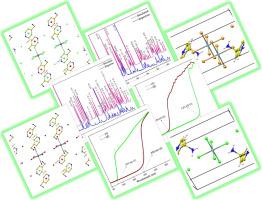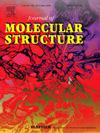双((吡啶-1-鎓-4-基)甲铵)六卤代锡烷酸(IV)二卤化物的合成、结构、光谱和希尔施菲尔德表面分析
IF 4
2区 化学
Q2 CHEMISTRY, PHYSICAL
引用次数: 0
摘要
新合成的有机-无机杂化盐,即双((吡啶-1-ium-4-yl)甲铵)六氯锡酸(IV)二氯化物(1)和双((吡啶-1-ium-4-yl)甲铵)六溴锡酸(IV)二溴化物(2)的单晶成功生长,随后利用单晶 X 射线衍射分析进行了详细表征。实验 X 射线衍射图显示出尖锐和高强度的峰值,证明了合成化合物的高结晶度和结构完整性。化合物(1)的带隙为 4.21 eV,化合物(2)的带隙为 2.93 eV。光致发光研究表明,这两种化合物在室温下的固态中都会发出荧光。此外,键价和计算还验证了锡的形式氧化态为 +4。 通过 Hirshfeld 表面分析研究了分子间的相互作用和晶体堆积。本文章由计算机程序翻译,如有差异,请以英文原文为准。

Synthesis, structure, spectral and Hirshfeld surface analysis of bis((pyridin-1-ium-4-yl)methanaminium) hexahalostannate(IV) dihalide
Single crystals of the newly synthesized organic-inorganic hybrid salts, namely bis((pyridin-1-ium-4-yl)methanaminium) hexachlorostannate(IV) dichloride (1) and bis((pyridin-1-ium-4-yl)methanaminium) hexabromostannate(IV) dibromide (2), were successfully grown and subsequently subjected to detailed characterization using single-crystal X-ray diffraction analysis. The experimental XRD patterns exhibit sharp and high-intensity peaks, attesting to the high crystallinity and structural integrity of the synthesized compounds. The band gaps of the hybrid materials can be effectively tuned by altering the halide ion, as evidenced by the different band gaps of 4.21 eV for compound (1) and 2.93 eV for compound (2). Photoluminescence investigations reveal that both compounds emit fluorescence in the solid state at room temperature. Additionally, bond valence sum calculations have verified that tin possesses a formal oxidation state of +4. Examination of intermolecular interactions and crystal packing through Hirshfeld surface analysis.
求助全文
通过发布文献求助,成功后即可免费获取论文全文。
去求助
来源期刊

Journal of Molecular Structure
化学-物理化学
CiteScore
7.10
自引率
15.80%
发文量
2384
审稿时长
45 days
期刊介绍:
The Journal of Molecular Structure is dedicated to the publication of full-length articles and review papers, providing important new structural information on all types of chemical species including:
• Stable and unstable molecules in all types of environments (vapour, molecular beam, liquid, solution, liquid crystal, solid state, matrix-isolated, surface-absorbed etc.)
• Chemical intermediates
• Molecules in excited states
• Biological molecules
• Polymers.
The methods used may include any combination of spectroscopic and non-spectroscopic techniques, for example:
• Infrared spectroscopy (mid, far, near)
• Raman spectroscopy and non-linear Raman methods (CARS, etc.)
• Electronic absorption spectroscopy
• Optical rotatory dispersion and circular dichroism
• Fluorescence and phosphorescence techniques
• Electron spectroscopies (PES, XPS), EXAFS, etc.
• Microwave spectroscopy
• Electron diffraction
• NMR and ESR spectroscopies
• Mössbauer spectroscopy
• X-ray crystallography
• Charge Density Analyses
• Computational Studies (supplementing experimental methods)
We encourage publications combining theoretical and experimental approaches. The structural insights gained by the studies should be correlated with the properties, activity and/ or reactivity of the molecule under investigation and the relevance of this molecule and its implications should be discussed.
 求助内容:
求助内容: 应助结果提醒方式:
应助结果提醒方式:


